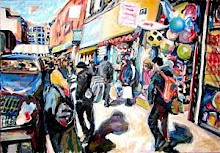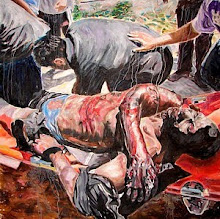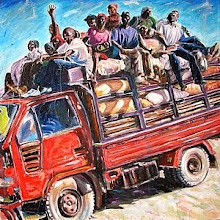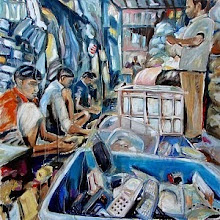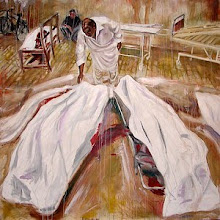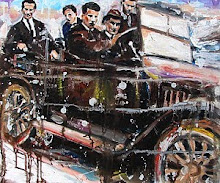Any authentic work of art must start an argument between the artist and his audience.
Rebecca West
Realism — in the meaning of the portrayal of things as they are seen without embellishment or interpretation — started in Europe and expanded to other parts of the world. It became a powerful tool to halt the flow of time by preserving images on canvas, and it came to dominate the world of art — until the emergence of photography. As photography took over most of the meaning of the realistic mode, abstract art flourished and prevailed. Artists applying the realistic mode were considered outdated, lagging behind, and became sort of outcasts.
Carla Bianpoen - The Jakarta Post
http://www.thejakartapost.com/news/2009/08/27/chusin-setiadikara-inventing-another-realism.html
Those who give their lives, their knowledge and their time to social struggle have the right to expect great help from the artist. And I cannot imagine a more inspiring role than that which the artist is asked to play for the defence and advancement of civilization.
Paraskeva Clark (1898-1986) Canadian painter
(Anne Newlands Canadian Art: From Its Beginnings To 2000. Firefly Books Ltd.(2000) pp. 74)

Jean-François Millet The Man with a Hoe 1863
http://commons.wikimedia.org/wiki/Category:Jean-Fran%C3%A7ois_Millet_%28II%29
Social Realism, also known as Socio-Realism, is an artistic movement, expressed in the visual and other realist arts, which depicts social and racial injustice, economic hardship, through unvarnished pictures of life's struggles; often depicting working class activities as heroic.
http://en.wikipedia.org/wiki/Social_realism
Can artists use visual art to explore the process of globalization in the same way that writers write about global events? The writer has to research generally accepted facts from many different sources. So too the artist should be able to research imagery to be used as the basis for his/her art. Just as the writer often has to rely on other people’s writings, the artist often depends on other people’s images, unless, of course, the writer or artist has the time and the finance to visit the places themselves.
However, the issue of authenticity can crop up, i.e., experiencing a situation oneself seems to be more important for the visual artist than the writer. Why is this? Writers and composers often make works of art based on situations outside their own direct experience. We can mention, for example, Persian Letters (Lettres persanes, written 1721), the satirical work by Montesquieu or the more modern example of Ge Gan-Ru’s String Quartet No 5 ("Fall of Bagdad"). Most artists work from photographs at some stage yet the romantic image of the artist on the street or in the fields en plein air seems to persist.
While there is no doubt that are many benefits to painting outdoors, the difficulties of painting en plein air are well described by the artist Berthe Morisot when she wrote to her sister in 1875:
I have worked a little, but what rain we have had for a week! Today we have been to Ryde. I set out with my sack and portfolio, determined to make a water-colour on the spot, but when we got there I found the wind was frightful, my hat blew off, my hair got in my eyes. Eugene was in a bad humour as he always is when my hair is in disorder - and three hours after leaving we were back at Globe Cottage.

Winslow Homer Artists Sketching in the White Mountains 1868
(http://en.wikipedia.org/wiki/En_plein_air)
In a subsequent letter she writes:
I made an attempt in a field, but the moment I had set up my easel more than fifty boys and girls were swarming about me, shouting and gesticulating. All this ended in a pitched battle, and the owner of the field came to tell me rudely that I should have asked for permission to work there [...] On a boat one has another kind of difficulty. Everything sways, there is an infernal lapping of water; one has the sun and the wind to cope with, the boats change position every minute etc.
(Christine Lindey Keywords of Nineteenth-Century Art)
Of course, experiencing and recording a situation oneself is possible today for many people through modern travel and photography. Yet is it morally better to take one´s own photographs rather than using other people´s? Kennedy Odede, a resident of Kibera, one of the largest slums in Africa, writes:
Slum tourism has its advocates, who say it promotes social awareness. And it’s good money, which helps the local economy. But it’s not worth it. Slum tourism turns poverty into entertainment, something that can be momentarily experienced and then escaped from. People think they’ve really “seen” something — and then go back to their lives and leave me, my family and my community right where we were before. I was 16 when I first saw a slum tour. I was outside my 100-square-foot house washing dishes, looking at the utensils with longing because I hadn’t eaten in two days. Suddenly a white woman was taking my picture. I felt like a tiger in a cage. Before I could say anything, she had moved on.
(http://www.nytimes.com/2010/08/10/opinion/10odede.html)

Wesley Allsbrook
(http://www.nytimes.com/2010/08/10/opinion/10odede.html)
Odede is sceptical of the long term benefits of such experience on the tourists:
To be fair, many foreigners come to the slums wanting to understand poverty, and they leave with what they believe is a better grasp of our desperately poor conditions. The expectation, among the visitors and the tour organizers, is that the experience may lead the tourists to action once they get home. But it’s just as likely that a tour will come to nothing. After all, looking at conditions like those in Kibera is overwhelming, and I imagine many visitors think that merely bearing witness to such poverty is enough. Nor do the visitors really interact with us. Aside from the occasional comment, there is no dialogue established, no conversation begun. Slum tourism is a one-way street: They get photos; we lose a piece of our dignity.
(http://www.nytimes.com/2010/08/10/opinion/10odede.html)

At right, Norman Rockwell’s After the Prom (1957), and the vignette he cast, composed, and oversaw the photographing of beforehand—a planning stage crucial to Rockwell’s creative process (http://www.vanityfair.com/culture/features/2009/11/norman-rockwell-200911).
Yet the photograph as a source has much in common with sources for the writer in the sense that it is based on the generally accepted facts of a situation. Of course, the source may catch out the unwary artist or writer but that does not undermine the verity of the generally known information about any given situation. So can the artist create art of a global nature and what is the role of such art? It seems to me that the art most fitted to exploring such issues is Social Realist art for reasons that will be discussed below, and its role is to help develop global solidarity.

James Christian Steward When Time began to Rant and Rage

Sean Keating Men of the South
http://www.crawfordartgallery.ie/Paintings/SKeating.html
The following essay will look at the issue of authenticity in Social Realist art by looking at photography as a medium which contains ‘facts’ to the same extent, more or less, as other media. This is more complex than it first appears and will be discussed in terms of authenticity of sources, content, and form. This will be followed up by an examination of Modernist and Postmodernist perspectives on authenticity and society, a brief history of Social Realism, a look at Social Realism and aesthetics from Tolstoy's perspective on the meaning and role of art in society, and finally how all this can be related to global solidarity.
Definitions – aspects of authenticity
Authenticity of source
Conforming to fact and therefore worthy of trust, reliance, or belief, for example, an authentic account by an eyewitness.
The facts of a situation can be in the form of a photograph, report, film or eyewitness account.
Do the sources of the artwork conform to the facts of a situation? An actor’s voiceover of actual dialogue is authentic in the sense that its source is known but due to censorship the source is not allowed to be used. Actors can act out an account of a torture scene.
For an artwork, facts can be taken from a photograph or film, or re-enacted by models based on an eyewitness account or report.
Thus the source of the facts is important in so far as it can be believed to be true or consistent with facts already generally agreed and accepted to be true.

Leon Golub Interrogation II 1981
http://artblogbybob.blogspot.com/2008/01/paint-it-black.html
Authenticity of content
Conforming to an original so as to reproduce essential features, for example, an authentic reproduction of a colonial farmhouse.
As above, the artwork can conform to the original by painting the essential features of the content of a photograph, thus retaining the authenticity of the content.

American soldiers stand behind a pyramid of naked Iraqi prisoners at the Abu Ghraib prison near Baghdad, Iraq in this undated photo.(AP Photo/Courtesy of The New Yorker) May 5, 2004 http://www.smh.com.au/news/After-Saddam/Abu-Ghraib-torturer-gets-10-years/2005/01/16/1105810774811.html

Fernando Botero Abu Ghraib
http://www.hwaethwugu.com/blog/archives/2006/11/18/fernando_boteros_abu_ghraib

Susan Crile Arranged: Naked Mound of Flesh 2005
http://www.myartspace.com/blog/archive/2008_12_01_blogmyartspace_archive.html
Authenticity of form
Worthy of acceptance or belief as conforming to or based on fact, for example, paints an authentic picture of society.
The artwork can conform to the facts of a situation and if the form used does not distort, undermine or negate the content of the facts contained therein, as far as the generally accepted facts allow, the artist can produce an authentic picture of a given situation.

George B. Luks Allen Street c.1905
http://ephemeralnewyork.wordpress.com/category/animals-with-jobs/
While the above examination of authenticity applies to Social Realist art, Modernist and Postmodernist art had/have a different attitude to authenticity.

Norman Rockwell Freedom of Speech 1943
http://www.artchive.com/artchive/R/rockwell/rockwell_speech.jpg.html
Modernist and Postmodernist perspectives on Authenticity
The term Modernism is given "retrospectively to the wide range of experimental and avant-garde trends in the arts that emerged from the middle of the 19th century, as artists rebelled against traditional Historicism, and later through 20th century as the necessity of an individual rejecting previous tradition, and by creating individual, original techniques." (http://www.huntfor.com/arthistory/c19th/modernism.htm)
Modernism tended towards a break from art history in terms of a more subjective approach to authenticity, that is faithful to the artist’s self and not external reality. As Harold Rosenberg writes:
"The aim of every authentic artist is not to conform to the history of art, but to release himself from it in order to replace it with his own history." (http://en.wikiquote.org/wiki/Harold_Rosenberg)
Postmodernist art on the other hand, "describes tendencies perceived as relativist, counter-enlightenment or antimodern, particularly in relation to critiques of rationalism, universalism or science." (http://en.wikipedia.org/wiki/Postmodernism) Thus, art theorists who took up the ideas of Roland Barthes and Jacques Derrida deconstructed formal values such as originality, authenticity and uniqueness in art.
Modernism, Postmodernism and the Social Realist project
Viewed from the perspective of Social Realist art, Modernism and Postmodernism create problems for the Social Realist project of creating "unvarnished pictures of life's struggles" as Modernism deconstructs form and Postmodernism deconstructs content.

John Sloan 14th Street at 6th Avenue c.1935
http://www.artlex.com/ArtLex/n/newdeal.html
Modernism rejected traditional forms which over time became less and less ´real´ and more abstract and conceptualised, (though not all Modernist art rejected Enlightenment thinking):
"Among modernists there were disputes about the importance of the public, the relationship of art to audience, and the role of art in society. Modernism comprised a series of sometimes contradictory responses to the situation as it was understood, and the attempt to wrestle universal principles from it. In the end science and scientific rationality, often taking models from the 18th-century Enlightenment, came to be seen as the source of logic and stability, while the basic primitive sexual and unconscious drives, along with the seemingly counter-intuitive workings of the new machine age, were taken as the basic emotional substance. […]The Russian Revolution catalyzed the fusion of political radicalism and utopianism, with more expressly political stances. Bertolt Brecht, W. H. Auden, André Breton, Louis Aragon and the philosophers Antonio Gramsci and Walter Benjamin are perhaps the most famous exemplars of this modernist Marxism." (http://en.wikipedia.org/wiki/Modernism)

Ben Shahn The Passion of Sacco and Vanzetti 1931-32
http://www.artlex.com/ArtLex/So.html
While traditional art forms are deconstructed in Modernism, content is deconstructed in Postmodernism:
"Postmodernism describes movements which both arise from, and react against or reject, trends in modernism. Specific trends of modernism that are generally cited are formal purity, medium specificity, art for art's sake, authenticity, universality, originality and revolutionary or reactionary tendency, i.e. the avant-garde. […] One compact definition is that postmodernism rejects modernism's grand narratives of artistic direction, eradicating the boundaries between high and low forms of art, and disrupting genre's conventions with collision, collage, and fragmentation. Postmodern art holds that all stances are unstable and insincere, and therefore irony, parody, and humor are the only positions that cannot be overturned by critique or revision." (http://en.wikipedia.org/wiki/Postmodern_art)
History of Social Realism
The term dates on a broader scale to the Realist movement in French art during the mid-1800s. Social Realism in the 20th century refers back to the works of the French artist Gustave Courbet and in particular to the implications of his 19th-century paintings A Burial at Ornans and The Stone Breakers, which scandalized French Salon–goers of 1850, and is seen as an international phenomenon also traced back to European Realism and the works of Honoré Daumier and Jean-François Millet. The Social Realist style fell-out of fashion in the 1960s but is still influential in thinking and the art of today.

Gustave Courbet A Burial at Ornans 1849-1850
http://commons.wikimedia.org/wiki/Gustave_Courbet
Many artists who subscribed to Social Realism were painters with socialist (but not necessarily Marxist) political views. The movement therefore has some commonalities with the Socialist Realism used in the Soviet Union and the Eastern Bloc, but the two are not identical - Social Realism is not an official art, and allows space for subjectivity. In certain contexts, Socialist Realism has been described as a specific branch of Social Realism.
http://en.wikipedia.org/wiki/Social_realism

Gustave Courbet The Stone Breakers 1849
http://commons.wikimedia.org/wiki/Gustave_Courbet
Social Realism developed as a reaction against idealism and the exaggerated ego encouraged by Romanticism. Consequences of the Industrial Revolution became apparent; urban centers grew, slums proliferated on a new scale contrasting with the display of wealth of the upper classes. With a new sense of social consciousness, the Social Realists pledged to “fight the beautiful art”, any style which appealed to the eye or emotions. They focused on the ugly realities of contemporary life and sympathized with working-class people, particularly the poor. They recorded what they saw (“as it existed”) in a dispassionate manner. The public was outraged by Social Realism, in part, because they didn't know how to look at it or what to do with it.
George Shi, University of Fine Arts, Valencia

Honoré Daumier Le Wagon de troisième classe (The third-class wagon) 1864
http://commons.wikimedia.org/wiki/Category:Paintings_by_Honor%C3%A9_Daumier
Social Realism in different forms
Since the days of Courbet´s Social Realist paintings the desire to reproduce reality has taken many different forms. New media replace older media in their ability to re-create ‘reality’. Still photography replaces painting, film photography replaces still photography and digitization replaces analogue film photography, 3D replaces 2D. Does that make one form better than another? No, as there are advantages and disadvantages to the different forms.
As Walter Benjamin writes about one of the advantages of painting in 'The Work of Art in the Age of Mechanical Reproduction':
The painting invites the spectator to contemplation; before it the spectator can abandon himself to his associations. Before the movie frame he cannot do so. No sooner has his eye grasped a scene than it is already changed. It cannot be arrested. Duhamel, who detests the film and knows nothing of its significance, though something of its structure, notes this circumstance as follows: “I can no longer think what I want to think. My thoughts have been replaced by moving images.” The spectator’s process of association in view of these images is indeed interrupted by their constant, sudden change.
http://www.marxists.org/reference/subject/philosophy/works/ge/benjamin.htm

Edward Hopper New York Movie 1939
http://www.edwardhopper.info/New-York-Movie.html
Different forms can lead us to think in different ways. A painting of a slum can lead us think about the poverty contained therein but a documentary, with its ability to include so much more information about the situation, can lead to confusions about whether or not they are worse off after all as our knowledge of, for example, their better sense of community could lead us to think that maybe slum life is not so bad after all. So at each level of reality the rhetoric of the image increases too, both in terms of image (quality) and expense (ideology). The better the quality of the image is the more we are led to believe it is true while the more money spent on the image the more it is limited to the ideology of those financially supporting the project.

George Bellows Cliff Dwellers 1913
http://en.wikipedia.org/wiki/George_Bellows
Therefore the reproduction of reality in art is no more and no less legitimate than in other forms. Newer forms do not replace older forms as being superior. Each form continues with its interpretation of reality through time yet not necessarily in isolation as the different forms can influence each other in terms of ways of seeing.

George Bellows Both Members of this Club 1909
http://en.wikipedia.org/wiki/George_Bellows
Social Realism and aesthetics
One could argue that Leo Tolstoy wrote a Social Realist manifesto when he wrote 'What is Art?' (http://cyberspacei.com/jesusi/authors/tolstoy/art/index.htm)', despite being quite a fundamentalist Christian himself. He believed that the concept of 'Beauty' was one developed by the upper classes for its own entertainment:
No longer able to believe in the Church religion, which had betrayed its own lie, and unable to adopt the true Christian teaching, which denied their entire life, these wealthy and powerful people, being left without any religious understanding of life, returned willy-nilly to that pagan world which locates the meaning of life in personal pleasure. [...] Having recognised pleasure - that is, beauty - as the standard of what is good, people of the upper classes of European society returned in their understanding of art to the crude understanding of the primitive Greeks, already condemned by Plato.
(Chapter VI)
Tolstoy contrasts the life of the labouring man with the art of the wealthy classes:
And this opinion, that the life of the labouring people is poor in content, while our life, the life of idle people, is full of interesting things, is shared by a great many people of our circle. The life of the labouring man, with its infinitely diverse forms of labour and the dangers connected with it on the sea or under the ground, with his travels, dealings with proprietors, superiors, comrades, with people of other confessions and nationalities, his struggle with nature, wild animals, his relations with domestic animals, his labours in the forest, the steppe, the fields, the orchard, the kitchen garden, his relations with his wife and children, not only as close and dear people but as co-workers, helpers, replacements in his work, his relation to all economic questions, not as subjects of discussion or vanity, but as questions vital for himself and his family, with his pride in self-sufficiency and service to others, with his pleasure in time off, and all these interests pervaded by a religious attitude toward these phenomena – to us, who have no such interests and no religious understanding, this life seems monotonous compared with the small pleasures and insignificant cares of our life, not of labour and creativity, but of the use and destruction of what others have made for us.
_-_Volga_Boatmen_(1870-1873).jpg)
Ilia Efimovich Repin Volga Boatmen 1870-1873
http://commons.wikimedia.org/wiki/Ilia_Efimovich_Repin
We think that the feelings experienced by people of our own time and circle are very significant and diverse, but in reality almost all the feelings of people of our circle come down to three very insignificant and uncomplicated feelings: the feelings of pride, sexual lust, and the tedium of living. And these three feelings, with their ramifications, make up almost exclusively the contents of the art of the wealthy classes.
(Chapter IX)
_-_Portrait_of_Leo_Tolstoy_(1887).jpg)
Ilya Efimovich Repin Portrait of Leo Tolstoy 1887
http://commons.wikimedia.org/wiki/Ilia_Efimovich_Repin
Tolstoy believed that:
Art begins when a man, with the purpose of communicating to other people a feeling he once experienced, calls it up again within himself and expresses it by certain external signs.
Thus the simplest case: a boy, who once experienced fear on encountering a wolf, tells about this encounter and, to call up in others the feeling he experienced, describes himself, his state of mind before the encounter, the surroundings, the forest, his carelessness, and then the look of the wolf, its movements, the distance between the wolf and himself, and so on.
All this - if as he tells the story the boy relives the feeling he experienced, infects his listeners, and makes them relive all that the narrator lived through - is art.
Even if the boy had not seen a wolf, but had often been afraid of seeing one, and, wishing to call up in others the feeling he experienced, invented the encounter with the wolf, telling it in such a way that through his narrative he called up in his listeners the same feeling he experienced in imagining the wolf - this, too, is art.
(Chapter V)
Thus, Tolstoy believed that relating one's experience or relating creatively something outside one's own experience forms the basis of a sense of community or solidarity. He sums up his view in the following way:
Art is not, as the metaphysicians say, the manifestation of some mysterious idea of beauty or God; it is not, as the aesthetical physiologists say, a game in which man lets off his excess of stored-up energy; it is not the expression of man's emotions by external signs; it is not the production of pleasing objects; and, above all, it is not pleasure; but it is a means of union among men, joining them together in the same feelings, and indispensable for the life and progress toward well-being of individuals and of humanity.
(Chapter V)

Chéri Samba SIDA (AIDS)
http://akorra.com/2010/08/17/top-10-famous-african-paintings/
Solidarity
An important aspect and often the driving force of Social Realism is solidarity with a group or class that struggles against injustice and hardship. As Aurora Levins Morales
writes:
Solidarity is not a matter of altruism. Solidarity comes from the inability to tolerate the affront to our own integrity of passive or active collaboration in the oppression of others, and from the deep recognition of our most expansive self-interest. From the recognition that, like it or not, our liberation is bound up with that of every other being on the planet, and that politically, spiritually, in our heart of hearts we know anything else is unaffordable.
(http://en.wikipedia.org/wiki/Social_solidarity)

Pablo Picasso Massacre in Korea 1951
http://en.wikipedia.org/wiki/Massacre_in_Korea
However, solidarity has tended to come from voluntary groups interested in helping others such as Médecins Sans Frontières, The International Red Cross and Red Crescent Movement, Oxfam International, Amnesty International etc. More recently efforts have been made to put the concept of international solidarity on a more solid foundation. The United Nations Human Rights Council has assigned an independent expert to work on a report in which he is developing the concept of a human right to international solidarity.
On October 1, 2009, a majority of the members of the Human Rights Council adopted a resolution taking note of the report and requesting the independent expert to continue his work, with emphasis on developing guidelines, standards, norms and principles for promoting international solidarity and analyzing developments in international economic, social, and “climate” fields.
http://www.globalgovernancewatch.org/spotlight_on_sovereignty/un-human-rights-council-adopts-a-socialist-view-of-international-solidarity
However this development is not the only new development as new radical-democratic global solidarity movements begin to come together and seek alternatives to capitalist globalisation.
.jpg)
Giuseppe Pellizza da Volpedo La fiumana (The Living Torrent) 1895-6
http://www.kunst-fuer-alle.de/english/art/artist/image/giuseppe-pellizza-da-volpedo/15203/9/106147/fiumana--1895-96/index.htm
In the realm of art, Social Realism is an art form which can also play an important role in highlighting injustice and hardship. In the words of Armstrong Williams:
In short, we cannot grow, we cannot achieve authentic discovery, and our eyes cannot be cleansed to the truly beautiful possibilities of life, if we simply live a neutral existence.

El Roto
http://www.elpais.com/vineta/?d_date=20100620&autor=El%20Roto&anchor=elpporopivin&xref=20100620elpepivin_3&type=Tes&k=Roto
Further Reading:
The Social and the Real: Political Art of the 1930s in the Western Hemisphere
Edited by Alejandro Anreus, Diana L. Linden, and Jonathan Weinberg
http://www.psupress.org/books/titles/0-271-02691-X.html
The Cultural Cold War: The CIA and the World of Arts and Letters (Paperback)
by Frances Stonor Saunders (Author)
http://www.amazon.co.uk/Cultural-Cold-War-World-Letters/dp/1565846648/ref=sr_1_4?ie=UTF8&s=books&qid=1275049804&sr=1-4
Facing Facts: Realism in American Thought and Culture, 1850-1920 (Paperback)
by David E. Shi (Author)
http://www.amazon.co.uk/Facing-Facts-Realism-American-1850-1920/dp/0195106539/ref=sr_1_8?ie=UTF8&s=books&qid=1275049970&sr=1-8
The Murals of Revolutionary Nicaragua 1979-1992 (Paperback)
by D Kunzle (Author)
http://www.amazon.co.uk/Murals-Revolutionary-Nicaragua-1979-1992/dp/0520081927/ref=sr_1_2?ie=UTF8&s=books&qid=1275009001&sr=8-2
Dimensions of the Americas: Art and Social Change in Latin America and the United States by Shifra Goldman (Ed.)
http://www.amazon.co.uk/Dimensions-Americas-Social-Change-America/dp/0226301249/ref=sr_1_4?ie=UTF8&s=books&qid=1277735106&sr=1-4
World (Social) Realist Art (Index of Countries)
This blog page is part of an ongoing project by artist and part-time lecturer Caoimhghin Ó Croidheáin (http://gaelart.net/) to explore Realist / Social Realist art from around the world. The term Realism is used in its broadest sense to include 19th century Realism and Naturalism as well as 20th century Impressionism (which after all was following in the path of Courbet and Millet). Social Realism covers art that seeks to examine the living and working conditions of ordinary people (examples include German Expressionism, American Ashcan School and the Mexican Muralists).
Click here for (Social) Realist Art Definitions, World (Social) Realism and Global Solidarity, Art and Politics, Social Realism in history and Country Index.
Suggestions for appropriate artists from around the world welcome to caoimhghin@yahoo.com.
